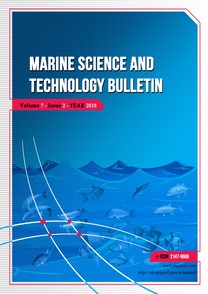Determination of Growth Conditions for Chlorella vulgaris
Microalgae known as third generation technology for biofuel in nature are used as a renewable bioenergy source. Microalgae and crop plants have common for the production of organic compounds by using sunlight and carbon dioxide. In addition, microalgae are capable of being reproducing in the whole year allowing the more product yield than those of plants. Therefore, microalgae are more favorable feedstock since they have some advantages such as photosynthetic efficiency, biomass productivity and oil content. In this study, the most proper conditions for the growth of microalgae Chlorella vulgaris were studied. After medium optimization, at 25°C and pH of 9 using 24-hour-illuminating/day, the best growth conditions for C. vulgaris giving the maximum biomass productivity was found to be 205 mg/L for 10 days. Determination of optimal microalgal growth conditions may lead to an increase in the industrial applications of C. vulgaris.
Keywords:
Chlorella vulgaris, Light, Microalgae, Optimization Temperature,
___
- Bach, Q. V. & Chen, W. H. (2017). Pyrolysis characteristics and kinetics of microalgae via thermogravimetric analysis (TGA): A state-of-the-art review. Bioresource Technology, 246: 88-100. https://doi.org/10.1016/ j.biortech.2017.06.087
- Converti, A., Casazza, A. A., Ortiz, E. Y., Perego, P. & Del Borghi, M. (2009). Effect of temperature and nitrogen concentration on the growth and lipid content of Nannochloropsis oculata and Chlorella vulgaris for biodiesel production. Chemical Engineering and Processing: Process Intensification, 48(6): 1146-1151. https://doi.org/10.1590/1678-457x.13417
- Ebrahimian, A., Kariminia, H.-R. & Vosoughi, M. (2014). Lipid production in mixotrophic cultivation of Chlorella vulgaris in a mixture of primary and secondary municipal wastewater. Renewable Energy, 71: 502-508. https://doi.org/10.1016/j.renene.2014.05.031
- Elrayies, G. M. (2018). Microalgae: prospects for greener future buildings. Renewable and Sustainable Energy Reviews, 81: 1175-1191. https://doi.org/10.1016/j.rser.2017.08. 032
- Faried, M., Samer, M., Abdelsalam, E., Yousef, R., Attia, Y. & Ali, A. (2017). Biodiesel production from microalgae: Processes, technologies and recent advancements. Renewable and Sustainable Energy Reviews, 79: 893-913. https://doi.org/10.1016/j.rser.2017.05.199
- Jankowska, E., Sahu, A. K. & Oleskowicz-Popiel, P. (2017). Biogas from microalgae: Review on microalgae’s cultivation, harvesting and pretreatment for anaerobic digestion. Renewable and Sustainable Energy Reviews, 75: 692-709. https://doi.org/10.1016/j.rser.2016.11.045
- Luangpipat, T. & Chisti, Y. (2017). Biomass and oil production by Chlorella vulgaris and four other microalgae–effects of salinity and other factors. Journal of Biotechnology, 257: 47-57. https://doi.org/10.3844/ojbsci.2015.260.267
- Mathimani, T., Bhumathi, D., Ahamed, T. S., Dineshbabu, G., Deviram, G., Uma, L. & Prabaharan, D. (2017). Semicontinuous outdoor cultivation and efficient harvesting of marine Chlorella vulgaris BDUG 91771 with minimum solid co-precipitation and high floc recovery for biodiesel. Energy Conversion and Management, 149: 13-25. https://doi.org/10.1016/ j.enconman.2017.06.077
- Sasi, D. (2009). Biokinetic behaviour of Chlorella vulgaris in a continuously stirred bioreactor and a circulating loop photobioreactor. Master Thesis, University of Saskatchewan, Canada.
- Serra-Maia, R., Bernard, O., Gonçalves, A., Bensalem, S. & Lopes, F. (2016). Influence of temperature on Chlorella vulgaris growth and mortality rates in a photobioreactor. Algal Research, 18: 352-359. https://doi.org/10.1016/ j.algal.2016.06.016
- Suthar, S. & Verma, R. (2018). Production of Chlorella vulgaris under varying nutrient and abiotic conditions: A potential microalga for bioenergy feedstock. Process Safety and Environmental Protection, 113: 141-148. https://doi.org/10.1016/j.psep.2017.09.018
- Tan, X. B., Lam, M. K., Uemura, Y., Lim, J. W., Wong, C. Y. & Lee, K. T. (2018). Cultivation of microalgae for biodiesel production: A review on upstream and downstream processing. Chinese Journal of Chemical Engineering, 26(1): 17-30. https://doi.org/10.1016/j.cjche.2017.08. 010
- Tijani, H., Abdullah, N. & Yuzir, A. (2015). Integration of microalgae biomass in biomethanation systems. Renewable and Sustainable Energy Reviews, 52: 1610-1622. https://doi.org/10.1016/j.rser.2015.07.179
- ISSN: 2147-9666
- Yayın Aralığı: Yılda 4 Sayı
- Başlangıç: 2012
- Yayıncı: Adem Yavuz SÖNMEZ
Sayıdaki Diğer Makaleler
Muhammad Qasim, Said Qasim, Naila Nazir
Semra Benzer, Qadeer Mohammad Ali, Quratulan Ahmed
Muhammad QASİM, Said QASİM, Naila NAZİR
Muammer KIRICI, Muhammed ATAMANALP, Mahinur KIRICI, Şükrü BEYDEMİR
Mahinur KIRICI, Muhammed ATAMANALP, Muammer KIRICI, Şükrü BEYDEMİR
Mustafa Karga, Soner Bilen, Yasemin Celik Altunoglu, Ferhat Ulu, Gouranga Biswas
Gökhan Arslan, Elif Yağanoğlu, Adem Yavuz Sönmez, Aycan Mutlu Yağanoğlu
